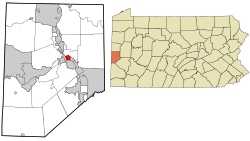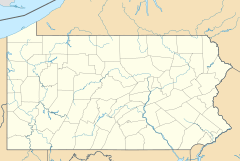Saucunk facts for kids
Quick facts for kids
Saucunk
|
|
|---|---|
|
Historic Native American village
|
|
| Etymology: Unami: pasakunk "at the mouth or fork of a stream." | |

Former location of Saucunk, present-day site of Rochester, Pennsylvania
|
|
| State | Pennsylvania |
| Present-day Community | Rochester, Pennsylvania |
| Founded | about 1725 |
| Abandoned | August, 1763 |
| Population | |
| • Estimate
(1758)
|
300-400 |
Saucunk (also called Sawcunk) was an important Native American village. It was built by the Lenape and Shawnees peoples. The village was also known by names like Soh-kon, Sacung, and Shingas' Town.
Saucunk was a center for Native American life and trade. Important Lenape chiefs like Tamaqua and Shingas lived there. Many visitors, including missionaries and traders, came to Saucunk. The village was left empty in 1763 after the Battle of Bushy Run. Today, the town of Rochester, Pennsylvania is located where Saucunk once stood.
Contents
What Does the Name Saucunk Mean?
The name "Saucunk" comes from the Lenape language. It is a shorter version of the word "pasakunk." This word means "at the mouth or fork of a stream." This name perfectly describes the village's location.
When Was Saucunk Established?
Saucunk was built where the Beaver Creek meets the Ohio River. The Lenape and Shawnee people likely started the village around 1725. This was during their journey westward. The village stretched along the Ohio River. For many years, it was the main home for the Turtle Division of the Lenape.
Important Visits to Saucunk
Many important people visited Saucunk. These visits show how important the village was.
Conrad Weiser's Visit in 1748
Conrad Weiser was a well-known peace negotiator. He visited Saucunk in 1748. He was on a trip to meet with Native American groups in the west. Weiser wrote in his journal that he went to "Beaver Creek, an Indian Town." He noted it was mostly Lenape people living there. He stayed at a trading house owned by George Croghan.
Christian Frederick Post's Visit in 1758
Christian Frederick Post was a Moravian missionary. He visited Saucunk in 1758. At first, the people in the village were not friendly. They thought the British wanted to take their land. Post wrote that they surrounded him with knives.
Later, Post met with two important Lenape war leaders. These leaders were White Eyes and Gelelemend. They had been against Post's peace talks before. But this time, they welcomed him kindly. They even said sorry for how they acted earlier.
George Croghan's Visit in 1758
George Croghan was a famous trader. He visited Saucunk in November 1758. This was right after the French left Fort Duquesne. Croghan wrote that Saucunk had 38 houses. The French had built these houses for the Native Americans. Some even had stone chimneys. He estimated the village could send out 100 warriors.
Saucunk During the French and Indian War
The French and Indian War (1754-1763) greatly affected Saucunk.
Saucunk as a Staging Area
In 1755, Saucunk was used by chiefs Captain Jacobs and Shingas. They used it as a base to launch attacks on British settlements. After the village of Kittanning was destroyed in 1756, Shingas and his brother Pisquetomen lived in Saucunk. They stayed until 1759. The ongoing war then made them move to Kuskusky. During this time, Saucunk was often called "Shingas' Town."
Captives in Saucunk
Some young people captured during the war were brought to Saucunk.
- Marie Le Roy and Barbara Leininger: These two 12-year-old girls were captured in 1755. They spent the winter of 1756 in Saucunk. They lived there, doing housework for the Native Americans.
- Hugh Gibson: Hugh was 14 when he was captured in 1756. He was adopted by Pisquetomen, Shingas' brother. In 1757, Gibson and Pisquetomen lived in Saucunk for a year. In 1759, Gibson escaped with Marie Le Roy and Barbara Leininger. They walked 250 miles to Fort Pitt.
- John McCullough: John was 8 years old when he was captured in 1756. He lived with a Lenape family for two and a half years. He then moved to a place possibly called Saucunk in late 1758. He was released in 1764.
Catholic Mission in Saucunk
In July 1757, a Jesuit priest named Father Claude Francis Virot started a Catholic mission in Saucunk. Another priest, Father Pierre Joseph Antonie Rouboud, joined him for a short time. However, the Lenape Chief Pakanke did not like missionaries. He became jealous of Virot's influence. Virot had to leave after the British captured Fort Duquesne in 1758. Virot was the only Jesuit to try starting a mission on the upper Ohio River.
The Lenape Move from Saucunk
In February 1759, Colonel Hugh Mercer met with the Lenape at Fort Pitt. At this meeting, Chief Tamaqua (also known as King Beaver) announced a decision. The Lenape wanted to move away from Saucunk. They wanted to avoid fighting between the French and British. Tamaqua said they would move to Kuskusky.
Mercer told them they could live wherever they wanted. In the spring of 1759, the Lenape moved. They left Saucunk and Kuskusky. They moved to new communities along the Muskingum River and the Scioto River in Ohio.
Why Was Saucunk Abandoned?
Saucunk was left empty after the Battle of Bushy Run in August 1763. This battle was a major defeat for the Native American forces. When Colonel Henry Bouquet passed through Saucunk in 1764, he saw the houses. He noted that the chimneys built by the French were still standing. He wrote that the Native Americans had left all their settlements in this area after their defeat at Bushy Run.
Fort McIntosh
In 1778, British General Lachlan McIntosh ordered a fort to be built. This fort, called Fort McIntosh, was built exactly where Saucunk had been. The construction of the fort likely removed any signs of the old Native American village.
Images for kids
-
1755 map by John Mitchell showing "Shingoes T.," just left of map's center.





